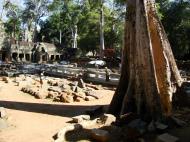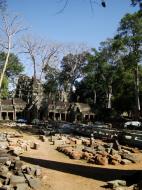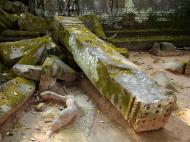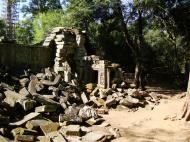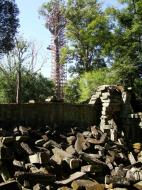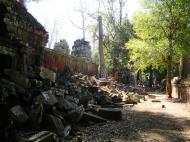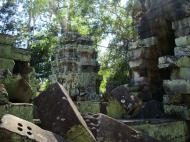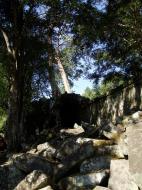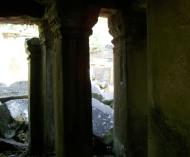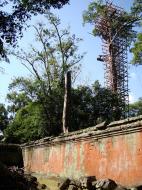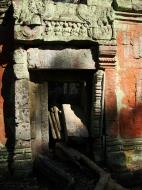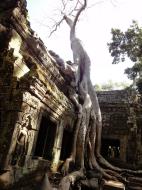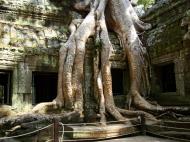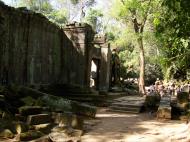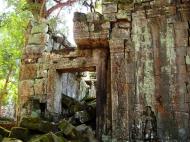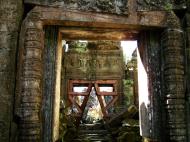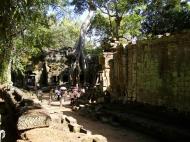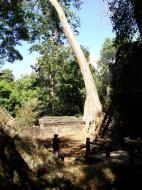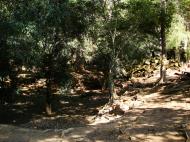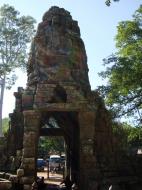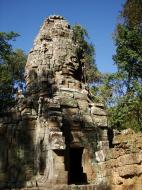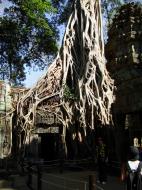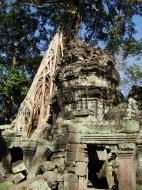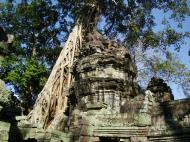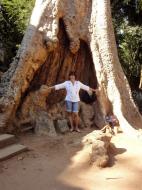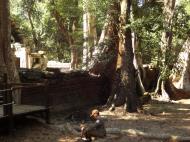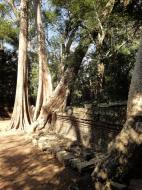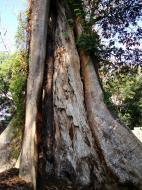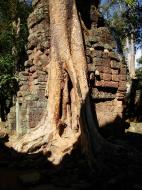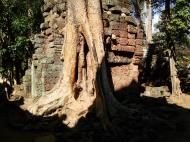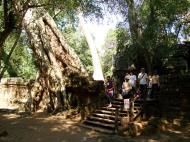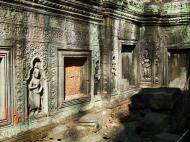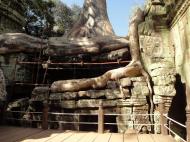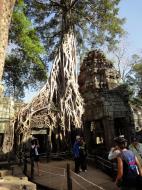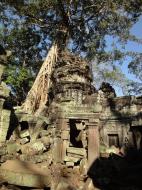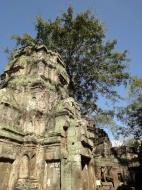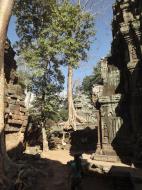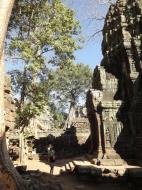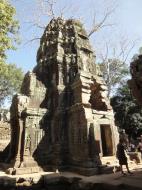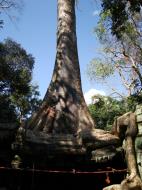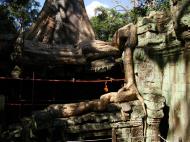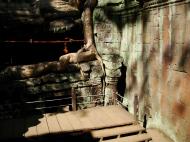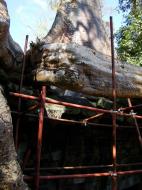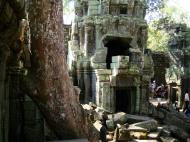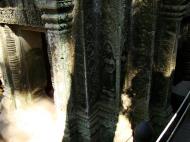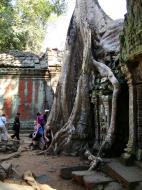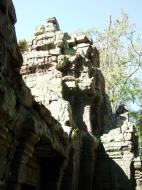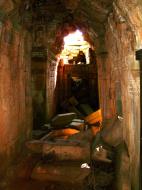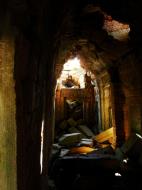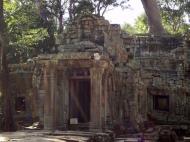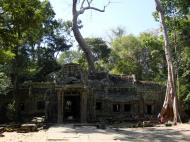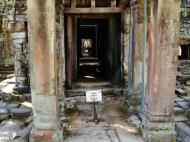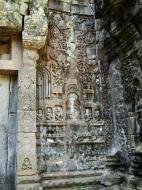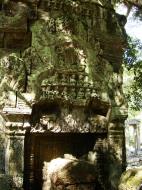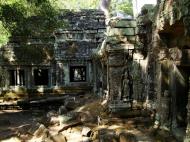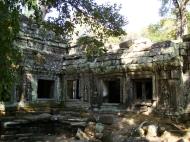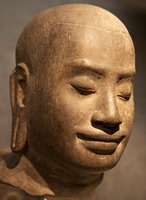Ta Prohm Temple - Rajavihara
Name: Ta Prohm (Rajavihara)
Creator: Jayavarman VII
Date built: 1186 A.D.
Primary deity: Prajnaparamita
Architecture: Khmer Bayon
Location: Angkor, Cambodia
Coordinates: 13°26'06?N 103°53'21?ETa Prohm is the modern name of a temple at Angkor, Cambodia, built in the Bayon style largely in the late 12th and early 13th centuries and originally called Rajavihara. Unlike most Angkorian temples, Ta Prohm has been left in much the same condition in which it was found: the photogenic and atmospheric combination of trees growing out of the ruins and the jungle surroundings have made it one of Angkor's most popular temples with visitors.
History of Ta Prohm
Foundation and expansion
Rajavihara (royal temple), today known as Ta Prohm (ancestor Brahma), was one of the first temples founded pursuant to that program.
The stele commemorating the foundation gives a date of 1186 A.D. The temple's main image, representing Prajnaparamita, the personification of wisdom, was modelled on the king's mother.
The northern and southern satellite temples in the third enclosure were dedicated to the king's guru and his elder brother respectively.Ta Prohm formed a complementary pair with the temple monastery of Preah Khan, dedicated in 1191_A.D., the main image of which represented the Bodhisattva of compassion Lokesvara and was modelled on the king's father.
The stele also notes that the temple amassed considerable riches, including gold, pearls and silks.
Abandonment and restoration
After the fall of the Khmer empire in the 15th century, the temple of Ta Prohm was abandoned and neglected for centuries. When the effort to conserve and restore the temples of Angkor began in the early 20th century, the École française d'Extrême-Orient decided that Ta Prohm would be left largely as it had been found, as a concession to the general taste for the picturesque. According to pioneering Angkor scholar Maurice Glaize, Ta Prohm was singled out because it was one of the most imposing temples and the one which had best merged with the jungle, but not to the point of becoming a part of it.
The site Layout
Five rectangular enclosing walls surround a central sanctuary. Like most Khmer temples, Ta Prohm is oriented to the east, so the temple proper is set back to the west along an elongated east-west axis. The outer wall of 1000 by 650 metres encloses an area of 650,000 square metres that at one time would have been the site of a substantial town, but that is now largely forested.
In the 13th century, face towers similar to those found at the Bayon were added to the gopuras. The three inner enclosures of the temple proper are galleried, while the corner towers of the first enclosure form a quincunx with the tower of the central sanctuary.
The basic plan is complicated for the visitor by the circuitous access necessitated by the temple's partially collapsed state, as well as by the large number of other buildings dotting the site, some of which represent later additions. The most substantial of these other buildings are the libraries in the southeast corners of the first and third enclosures; the satellite temples on the north and south sides of the third enclosure; the Hall of Dancers between the third and fourth eastern gopuras; and a House of Fire east of the fourth eastern gopura.
Representational Art
Ta Prohm has few narrative bas-reliefs. One explanation that has been proffered for this dearth is that much of the temple's original Buddhist narrative artwork must have been destroyed by Hindu iconoclasts following the death of Jayavarman VII.
The temple also features stone reliefs of devatas (minor female deities), meditating monks or ascetics, and dvarapalas or temple guardians. The trees growing out of the ruins are perhaps the most distinctive feature of Ta Prohm, and have prompted more writers to descriptive excess than any other feature of Angkor. Indulging in what might be regarded as descriptive excess, Angkor scholar Maurice Glaize observed, On every side, in fantastic over-scale, the trunks of the silk-cotton trees soar skywards under a shadowy green canopy, their long spreading skirts trailing the ground and their endless roots coiling more like reptiles than plants.
Ta Prohm Temple was used as a location set in the film Tomb Raider. Although the film took visual liberties with other Angkorian temples, its scenes of Ta Prohm were quite faithful to the temple's actual appearance, and made use of its eerie qualities. Go Lara Croft!
Jayavarman VII King of the Khmer Empire (c.1181-1215)
Reign: Khmer Empire: 1181-1218
Full name: Jayavarthon
Birthplace: Angkor
Died: 1218
Place of death: Angkor
Predecessor: Yasovarman II Indravarman
Successor: Indravarman II
Consort: Indradevi
Consort: Jayarachadevi (Queen's Sister)
Father: Dharanindravarman IIJayavarman VII (1125 - 1215) was a king of the Khmer Empire (c.1181-1215and was the son of King Dharanindravarman II (r. 1150-1160) and Queen Sri Jayarajacudamani. He married Jayarajadevi and then, after her death, married her sister Indradevi. The two women are commonly thought to have been a great inspiration to him, particularly in his unusual devotion to Buddhism. Only one previous Khmer king had been a Buddhist.
Jayavarman's Early Years
Jayavarman probably spent his early years away from the Khmer capital. He may have spent time among the Cham of modern-day Vietnam. In 1178, they launched a surprise attack on the Khmer capital by sailing a fleet up the Mekong River, across Lake Tonle Sap, and then up the Siem Reap River, a tributary of the Tonle Sap. The invaders pillaged the Khmer capital of Yasodharapura and put the king to death, as well as taking the Apsara dancers. Also in 1178, Jayavarman came into historical prominence by leading a Khmer army that ousted the invaders.
Returning to the capital, he found it in disorder. Early in his reign, he probably repelled another Cham attack, quelled a rebellion, and rebuilt the capital of Angkor. Over the 30 some years of his reign, Jayavarman embarked on a grand program of construction that included both public works and monuments. As a Mahayana Buddhist, his declared aim was to alleviate the suffering of his people. One inscription tells us, 'He suffered from the illnesses of his subjects more than from his own; the pain that affected men's bodies was for him a spiritual pain, and more piercing.'
The declaration must be read in light of the undeniable fact that the numerous monuments erected by must have required the labor of thousands of workers, and that Jayavarman's reign was marked by the centralization of the state and the herding of people into ever greater population centers. Historians have identified three stages in Jayavarman's building program. He constructed his own 'temple-mountain' at Bayon and developed the city of Angkor Thom around it.
Ta Prohm
In 1186, Jayavarman dedicated Ta Prohm ('Ancestor Brahma') to his mother. An inscription indicates that this massive temple at one time had 80,000 people assigned to its upkeep, including 18 high priests and 615 female dancers. The first Lara Croft film was shot in Ta Prohm as well as a few scenes from the movie Troy.
Preah Khan
Jayavarman also built the temple and administrative complex of Preah Khan ('Sacred Sword'), dedicating it to his father in 1191.
Angkor Thom and Bayon
At the centre of the new city stands one of his most massive achievements -- the temple now called the Bayon, a multi-faceted, multi-towered temple that mixes Buddhist and Hindu iconography. The reliefs show camp followers on the move with animals and oxcarts, hunters, women cooking, female traders selling to Chinese merchants, and celebrations of common footsoldiers. The reliefs also depict a naval battle on the great lake, the Tonle Sap.
Fixing the Dates
The historical record is a mixture of the incredibly precise (we know the exact date that a temple was consecrated) and more ambiguous texts and archaeological evidence. Many of the dates marking the life and reign of Jayavarman VII are a matter of conjecture and inference. There is a minority view that the current biography of Jayavarman is imaginary and that the evidence could just as easily support the view that he was the usurper.
One date that has been generally accepted is 1177 when the Chams, who had themselves been subjected to numerous Khmer invasions, took the city of Yashodharapura. A Cham king took the title of Jaya-Indravarman.
In 1181 Jayavarman VII became King after leading the Khmer forces against the Chams. Jayavarman died in about 1215, at an advanced age ranging from 85 to 90. Indravarman was succeeded by Jayavarman VIII who it is thought supported a Hindu revolt. The niches all along the top of the wall around the city contained images of the Buddha. A statue of Jayavarman VII was found by excavators having been thrown down a well. Buddha images in Preah Khan were re-worked to resemble Brahmins. When Cambodia finally did become a Buddhist country, it followed Theravada Buddhism, not the Mahayana Buddhism practised by Jayavarman VII.
Interpretation
Care must be taken not read European patterns of kingship, inheritance or nationhood onto the history of the Khmer empire. Sons did not necessarily inherit their father's thrones; Jayavarman VII himself had many sons, such as Suryakumara and Virakumara, who were crown princes (the suffix kumara usually is translated as crown prince).
Jayavarman VII remains a potent symbol of national pride for present day Cambodians. This has contributed to a legend of the Buddharaja, the King-Buddha, who privileged compassion in ruling. This view of Jayavarman and his reign is supported by some beautiful portrait sculpture of him in meditation.
References
A fictionalised account of the life of Jayavarman VII forms the basis of Geoff Ryman's 2006 novel ‘The King's Last Song’.
Statue of Jayavarman VII, Guimet Museum http://en.wikipedia.org/wiki/File:JayavarmanVII.jpg
Ta Prohm Temple, Siem Reap, Cambodia Map
 Editor for Asisbiz: Matthew Laird Acred
Editor for Asisbiz: Matthew Laird Acred
If you love our website please add a like on facebook
Please donate so we can make this site even better !!






